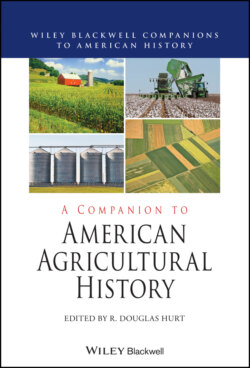Читать книгу A Companion to American Agricultural History - Группа авторов - Страница 18
HOHOKAM AGRICULTURE
ОглавлениеBy 450 CE, the culture known as Hohokam, which was based on intensive farming, developed in the Phoenix and Tucson basins and immediately surrounding areas. Maize was ubiquitous, as it had been previously, but additional crops had joined the system. These included common beans, lima beans (Phaseolus lunatus), and tepary beans (Phaseolus acutifolius). Teparies are supremely well adapted to Sonoran Desert aridity and were possibly domesticated north of the Mesoamerican culture area, in northwestern Mexico (Muñoz et al. 2006). Squash species grown along with Cucurbita pepo ssp. pepo include the cushaw squash (C. argyrosperma ssp. argyrosperma) and butternut squash (C. moschata). Cotton (Gossypium hirsutum var. punctatum) was an important Hohokam fiber crop, utilized locally and traded to regions where neither irrigation nor rainfall were adequate for meeting its moisture requirements (Adams and Fish 2011). Two species of cultigen amaranth—Amaranthus cruentus and A. hypochondriacus were grown for grain and probably other uses including edible green leaves (similar to spinach, mustard greens, collard greens) and dye (Fritz et al. 2009).
Agaves (Agave spp.) are recognized as locally cultivated crops essential to the Hohokam economy (Adams and Fish 2011; Fish and Fish 2014; Hodgson, Salywon, and Doelle 2018). They were grown in rockpile fields that extended for kilometers along the lower slopes of bajadas, above irrigable river terraces but at lower elevations than where wild agave plants thrive without human care. Extensive rockpile-dotted landscapes yield tabular stone knives used for stripping leaves from agave hearts, and the fields include large roasting pits for baking the carbohydrate-rich hearts. Agaves were not only an important source of food, but their fibers were used for ropes and textiles, and drinks were likely made from the sugary juice in ancient times as they are still today. Wendy Hodgson and colleagues (2018) recognize seven extant species of agave in the Southwest as surviving examples of ancient domesticates. Most are rare today and found only in proximity to archaeological settlements and/or ancient rockpile fields (Figure 1.4).
Figure 1.4 Agave murpheyi growing in a cultivated rockpile field at the Arizona Sonora Desert Museum. Source: Photo by the author (Gayle Fritz), April 2002.
The Hohokam culture is justifiably called “one of the major irrigation societies in the ancient world” (Adams and Fish 2011). Canal construction began by 650 CE, with trunkline canals in the Phoenix Basin alone extending over 500 km in length. Canals connected irrigation communities that were integrated socially by ballcourts before c. 1150 CE, and later by platform mounds and adobe “great houses” such as the one preserved at Casa Grande National Monument. A high level of coordination anchored by experts with superb engineering and agronomic skills was required for construction and maintenance of canal systems of this magnitude.
Other forms of water management coexisted with canal irrigation. These included: (i) diversion of runoff from seasonal storms, sometimes using structures made of brush and earth; (ii) check dams; (iii) stone terraces; (iv) reservoirs; (v) stone or earthen grids for moisture retention; and (vi) rock mulches (Adams and Fish 2011). Wild and managed plants were always important foods, with some, such as mesquite pods, being stored along with crops. Many seeds from species of weedy plants probably reflect use of tolerated, encouraged, or cultivated resources that grew in and near formal fields.
Several crops native to the Sonoran Desert, in addition to agaves, seem to have been domesticated to some extent by ancient farmers in this region. Sonoran panic grass (Panicum sonorum), with large, pale grains and heavy panicles, was a notable floodplain crop formerly sown in receding floodwaters of the lower Colorado River by Yuman-speaking forager-farmers and still grown by Piman groups in Sonora, Mexico (Nabhan and DeWet 1984). Little barley (Hordeum pusillum) seeds show signs of selection for naked (hull-less) grains (Adams 2014). Devil’s claw (Proboscidea parviflora) was bred for longer, more pliable fibers, but not until a market for O’odham baskets arose in historic times (Nabhan et al. 1981). Cholla (Cylindropuntia spp.) and Mexican crucillo (Condalia warnockii var. kearneyana) may also have been transplanted or otherwise cultivated, judging by archaeological distributions outside their known phytogeographic ranges (Bohrer 1991).
The “Hohokam Millennium,” started before 500 ce, was over by 1500 CE (Fish and Fish 2007). Europeans encountered Pima-speaking farmers in the Salt and Gila river valleys growing maize, squashes, and beans including the tepary, but population density and degree of sociopolitical integration were far lower than before. Platform mounds and great houses were no longer built. The massive irrigation canals fell into disuse, although Native farmers still used small-scale water management systems. Traditional agricultural knowledge was passed on, however, and desert-adapted landraces are still grown by members of Tohono O’odham (Papago), Akimel O’odham (River Pima), Raramuri, and Pima Bajo communities in southern Arizona and northwestern Mexico.
